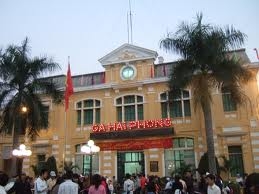Hai Phong not only has sea and islands to attract tourists

Beautiful beaches and islands have always been the most attractive things that lure tourists to the city. Meanwhile, a lot of original cultural resources of the city remain unfamiliar to tourists.
At a press conference held in early 2013, Nguyen Nga, the owner of the House of the Arts, the author who has been well known with the arts exhibition on the Long Bien bridge in Hanoi in 2010, suggested designing a new tour, under which travelers would go along the Red River, from the upstream in Phu Tho province to the downstream in Hai Phong City, where they would stay to discover the mainland culture of the port city.
The tour suggested by Nga seems to have no close relations to beaches or islands, which have been considered the biggest advantages of Hai Phong City to attract tourists.
The representatives of the travel firms present at the press conference startled when hearing the suggestion, because they could not understand why they did not think of developing such a tour before.
They have also realized that they forgot the grandiose cultural heritage of Hai Phong which could become the charm to attract travelers. These include communal houses in villages, temples and pagodas, from ancient architecture styles to festivals and folklore, from the history of the biggest commercial port in the north to the celebrities.
Doan Duy Linh, Deputy Director of the Hai Phong City Department of Culture, Sports and Tourism, also said that the ancient communal houses in villages, ancient citadels and temples built under the Le and Mac dynasties alone would be enough to design a wonderful historical and spiritual tour.
Linh named a lot of precious historical relics such as the Tuong Long Temple on the Ngoc mountain top built under the Ly Thanh Tong King dynasty, the network of the pagodas and communal houses built under the dynasties of Ly, Tran and Le Kings which have original architectural and art values.
The pagodas have been well known among local residents, including the Long Hoa pagoda on the Voi Mountain in An Lao district, Thien Vu and Tham Khe pagodas in Thuy Nguyen district, Du Hang pagoda in Le Chan district and Kien Bai communal house in Thuy Nguyen district.
Especially, tourists would feel wonderful if they have the chance to see Duong Kinh ancient citadel, which is called a Thang Long – Hanoi miniature that existed in 1527-1592 with valuable archaeology relics.
Hai Phong can attract tourists not only with the feudal cultural value, but also with the architecture system of the ancient port city. All the ancient streets, harbors and old markets in Hanoi could be developed into attractive tourism products.
One of the wonderful architecture works of Hai Phong is the Big Theatre, one of the biggest theaters built by the French colonialist in Indochina, and Quan Hoa – another French construction work that bears the typical Asian-European style.
Linh also mentioned the other two valuable resources of the Hai Phong – traditional festivals and culinary culture. The Do Son buffalo fight festival attracts hundreds of thousands of travelers to the beach every year. Meanwhile, Hai Phong’s culinary culture was praised at Brest 2008 festival in France.
Luu Duc Ke, Director of Hanoitourist, has noted that Hai Phong has all necessary conditions to attract tourists. The only thing that needs to be done now is to design creative tour products.
“In order to attract tourists and retain them in the city, you should not only offer them sea bathing services and seafood,” Ke said.









